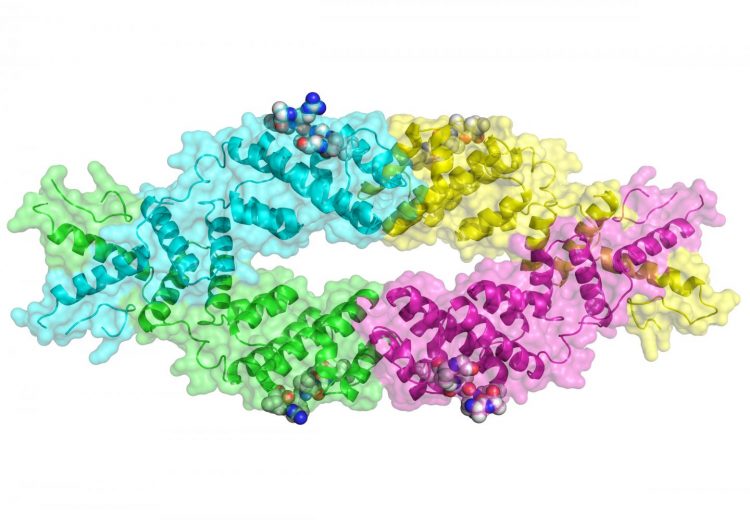TOPLESS plants provide clues to human molecular interactions

The tetrameric TOPLESS complex with the EAR motif peptides bound at its repressor-peptide binding grooves. The repressor peptides are shown as a ball presentation. Credit: Karsten Melcher, Ph.D., Van Andel Research Institute
In plants as in animals and humans, intricate molecular networks regulate key biological functions, such as development and stress responses. The system can be likened to a massive switchboard–when the wrong switches are flipped, genes can be inappropriately turned on or off, leading to the onset of diseases.
Now, VARI scientists have unraveled how an important plant protein, known as TOPLESS, interacts with other molecules responsible for turning genes off. The findings in plants provide a general model across species for this type of gene silencing, which is linked to several vital biological functions in humans. The discovery was published today in Science Advances.
“This is really a fundamental discovery–our structure shows the corepressor TOPLESS interacting with key repressor motifs, which constitutes a major component of gene silencing in plants,” said Van Andel Research Institute's Karsten Melcher, Ph.D., one of the study's corresponding authors. “Understanding this interaction in plants gives us unique insight into similar pathways in humans that involve these proteins, which are notoriously tough to investigate.”
Using a method called X-ray crystallography, the team determined the three- dimensional structure of TOPLESS, both on its own and when linked with other molecules responsible for turning genes off, thereby regulating gene expression. Although these interacting molecules were chosen from different signaling pathways in plants, they all linked up with TOPLESS in the same manner
“This structure will allow us to take a more targeted approach to investigating TOPLESS's counterparts in humans and significantly expands our knowledge base,” said VARI's H. Eric Xu, Ph.D., who also is a corresponding author. “We're extremely excited to continue this work to better understand these proteins and how they interact with other molecules in health and disease states.”
The new paper is the third in a trio of publications that unveil key components of fundamental molecular processes. Although the new study provides further insight into human molecular pathways, the work also directly describes how components of the molecular switchboard in plants interact to regulate responses to a multitude of stressors, including temperature fluctuations. The new findings follow an earlier Nature paper, which was included in the top ten list of scientific breakthroughs of 2009 by Science magazine, and an earlier Science paper, both of which describe how plants respond to drought and temperature stress. Taken together, the papers not only have implications for developing hardier plants but also for determining molecular structures for components of entire pathways.
Authors include Jiyuan Ke, Honglei Ma, and Xin Gu of VARI and VARI-Shanghai Institute of Materia Medica; Jiayang Li of the Chinese Academy of Sciences; Joseph S. Brunzelle of Northwestern University; and Adam Thelen, now at Michigan State University.
###
Additional background information on TOPLESS and gene regulation:
Gene expression is regulated by both activators and repressors. Although gene repression is thought to be equally important as gene activation for this regulation, relatively little is known about the mechanisms of gene repressors and co-repressors.
TOPLESS functions as a co-repressor and interacts with repressors containing ethylene-responsive element binding factor-associated amphiphilic repression (EAR) motifs. EAR motifs are the most common form of transcriptional repression motifs found in plants and are thought to facilitate stable epigenetic regulation of gene expression via recruitment of chromatin modifiers.
TOPLESS plays important roles in plant development; its name stems from the fact that mutations in TOPLESS can give rise to seedlings in which the shoot is transformed into a second root, hence “topless” seedlings.
In humans, similar proteins also are altered in many types of tumors, and control embryonic development and the development of neurons.
ABOUT VAN ANDEL RESEARCH INSTITUTE:
Van Andel Institute (VAI) is an independent biomedical research and science education organization committed to improving the health and enhancing the lives of current and future generations. Established by Jay and Betty Van Andel in 1996 in Grand Rapids, Michigan, VAI has grown into a premier research and educational institution that supports the work of more than 270 scientists, educators and staff. Van Andel Research Institute (VARI), VAI's research division, is dedicated to determining the epigenetic, genetic, molecular and cellular origins of cancer, Parkinson's and other diseases and translating those findings into effective therapies. The Institute's scientists work in on-site laboratories and participate in collaborative partnerships that span the globe. Learn more about Van Andel Institute or donate by visiting http://www.
Media Contact
All latest news from the category: Life Sciences and Chemistry
Articles and reports from the Life Sciences and chemistry area deal with applied and basic research into modern biology, chemistry and human medicine.
Valuable information can be found on a range of life sciences fields including bacteriology, biochemistry, bionics, bioinformatics, biophysics, biotechnology, genetics, geobotany, human biology, marine biology, microbiology, molecular biology, cellular biology, zoology, bioinorganic chemistry, microchemistry and environmental chemistry.
Newest articles

A ‘language’ for ML models to predict nanopore properties
A large number of 2D materials like graphene can have nanopores – small holes formed by missing atoms through which foreign substances can pass. The properties of these nanopores dictate many…

Clinically validated, wearable ultrasound patch
… for continuous blood pressure monitoring. A team of researchers at the University of California San Diego has developed a new and improved wearable ultrasound patch for continuous and noninvasive…

A new puzzle piece for string theory research
Dr. Ksenia Fedosova from the Cluster of Excellence Mathematics Münster, along with an international research team, has proven a conjecture in string theory that physicists had proposed regarding certain equations….



